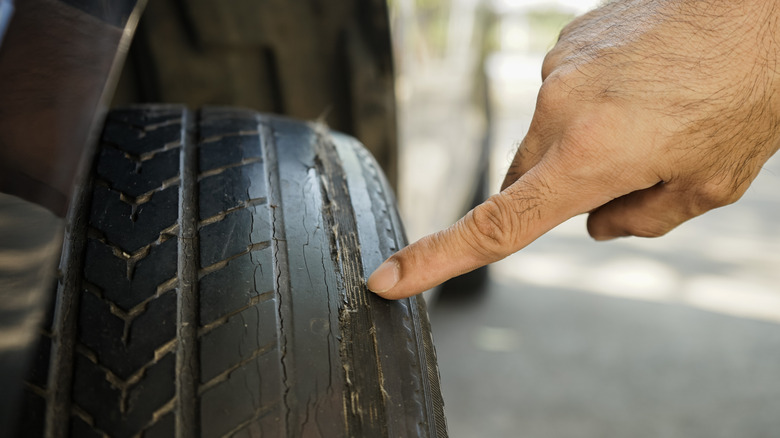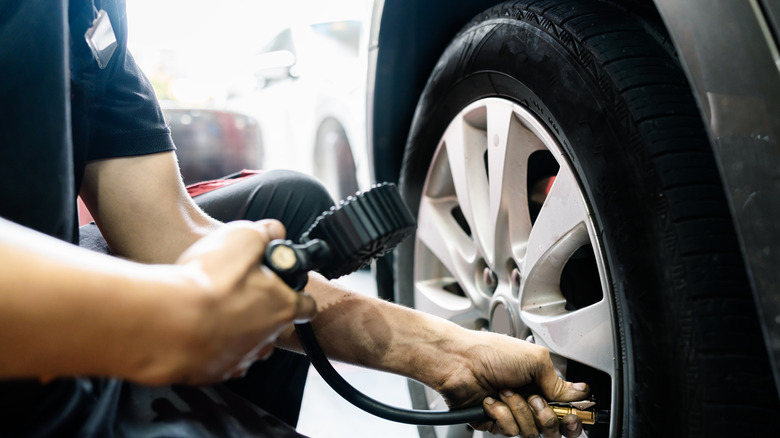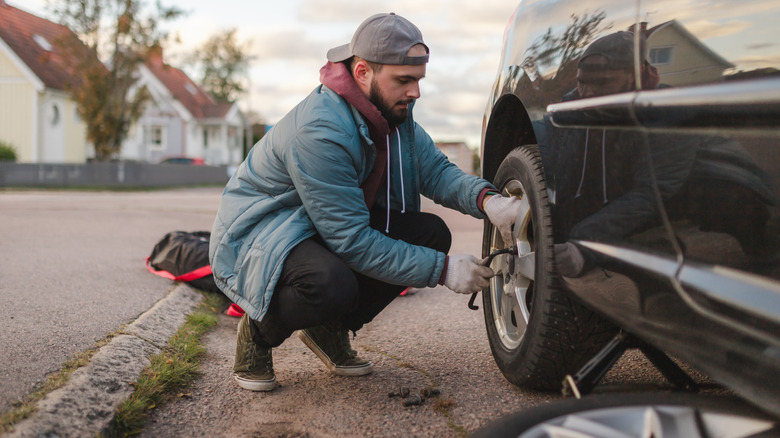What Are The Warning Signs Of A Tire Blowout? Here's What To Look For
If you've never experienced a tire blowout on your vehicle, consider yourself lucky. There are lots of ways a tire can fail, but unlike a slow leak over a long amount of time or a flat that happens as the result of a nail, releasing a tire's air over a few minutes, a blowout is far more alarming. Like the name suggests, a blowout happens when there's a rapid change in tire pressure. Pieces of tire tread and sidewall can go flying everywhere, and the entire event feels a bit like a powder keg has exploded underneath your vehicle.
On top of the shock associated with a tire blowout, serious accidents can happen as a result, or big damage to the vehicle you're driving. Naturally, then, we should probably do all we can to avoid tire blowouts, and if you're paying attention, there are some warning signs to look for ahead of time. Keeping an eye on your tires over time by visually inspecting them on a regular basis is the first and easiest way to avoid a blowout. Tires show signs of age like cracking in the sidewalls, low tread, or uneven wear – all of which can be spotted just by looking at your tires, especially as they age.
Look closely and check your tire pressure regularly
When tires sit out in the sun or are subject to especially dry conditions, they can develop cracks, especially in the sidewall. If you start to see cracks or cuts in the sidewall, it's time to look into replacing the tires. Even if they aren't cracked, though, tires can still be beyond their useful life. Like milk in the fridge, tires can go bad over time even if they're kept at the right temperature. Check the production dates on your tires to ensure you're not driving on compromised rubber, especially if you drive an older vehicle. Most manufacturers recommend replacing your tires every six years, even if there's still plenty of tread left.
On top of checking for cracks in the rubber, you should be regularly checking the tire pressure in your vehicle's tires and making sure it aligns with the manufacturer's specifications. Low pressure alone can lead to a blowout. Lots of modern cars have tire pressure monitoring systems that allow you to do this via computer on your dashboard, but if your car doesn't have one of these systems, tire pressure gauges are relatively easy to purchase and use. Tire pressures change based on ambient temperature, so be sure to keep an eye on pressures year-round, even if your tire isn't leaking, and especially if you live in an area with big fluctuations in temperature.
What to do if there's a blowout
Even if you pay close attention to the health of your tires, there's still the possibility of a blowout. So, what do you do if one happens? According to the National Highway Traffic Safety Administration (NHTSA), the goal is to maintain control of your vehicle. Resist the urge to slam on the brakes. Doing so could make you lose control, especially if the blowout has occurred on one of the front tires.
Decelerate gradually and keep both hands on the steering wheel. A wheel without tire tread can cause unpredictable directional changes in the car, pulling you in one direction or another. Finally, once you've got the car slowed down properly, and if it's safe to do so, pull off the road out of harm's way. This is where some sort of emergency kit comes in handy, and if your car happens to have a spare wheel/tire, that will come in handy too. If you want to be extra prepared, practice removing and replacing a wheel and tire at home, from the comfort of your own driveway. Knowing where all your tools are located and how to change a tire quickly will help with roadside stress levels.


